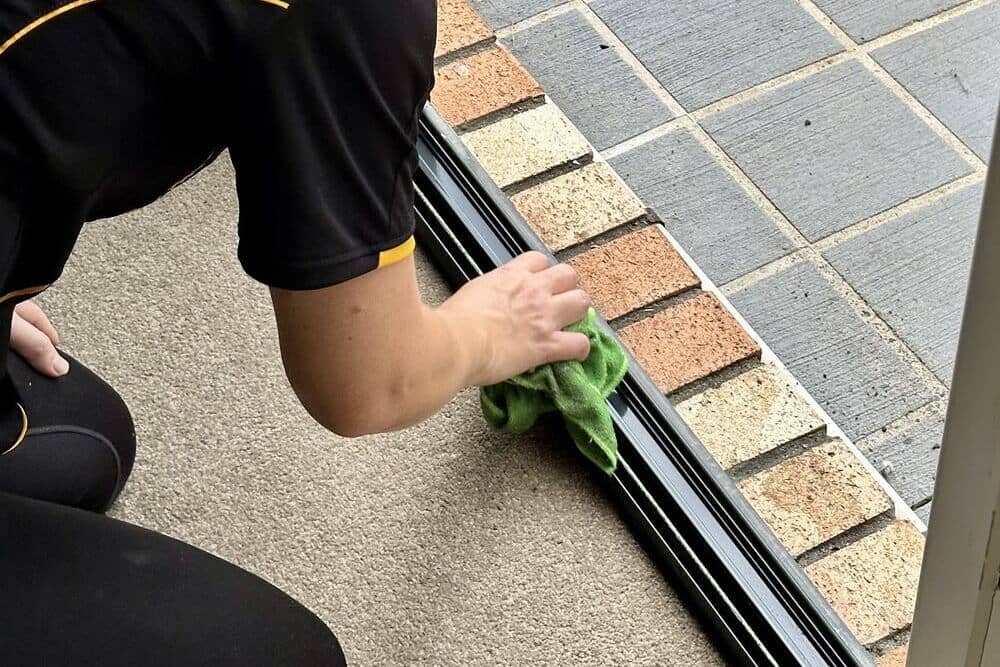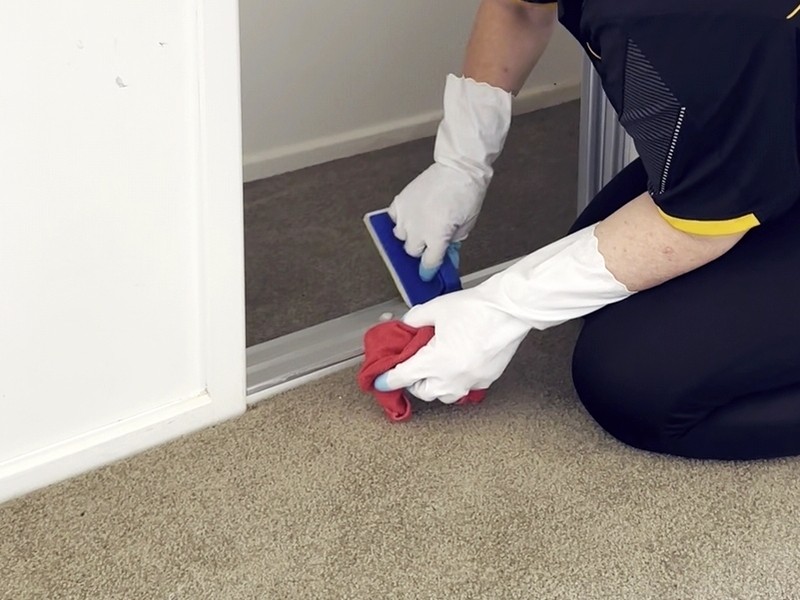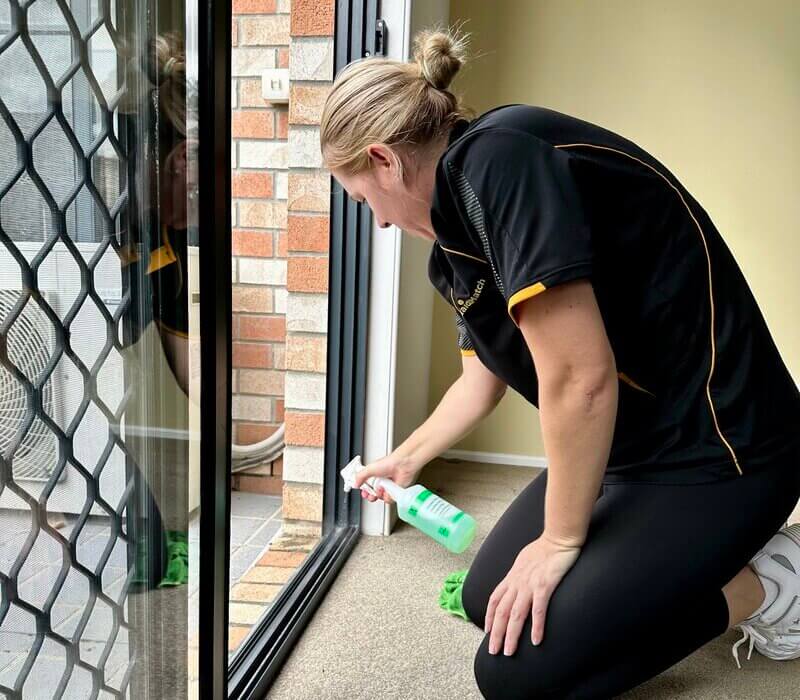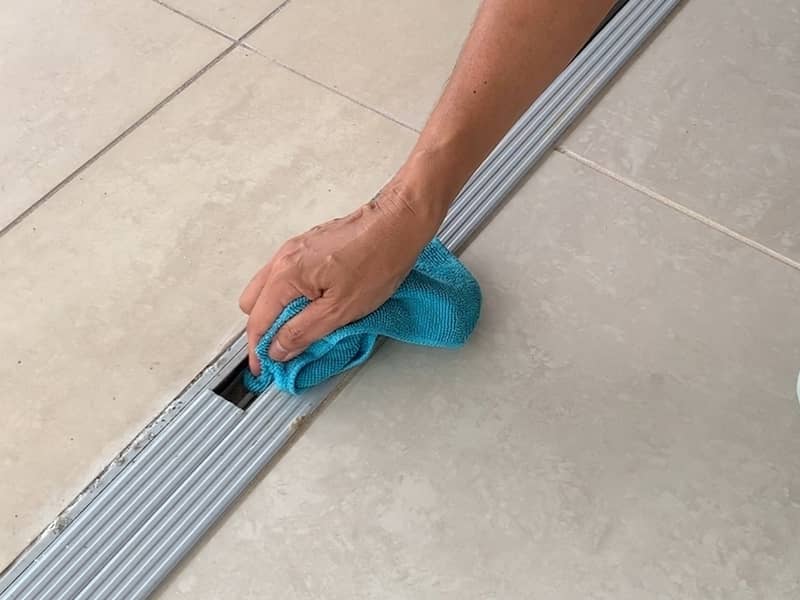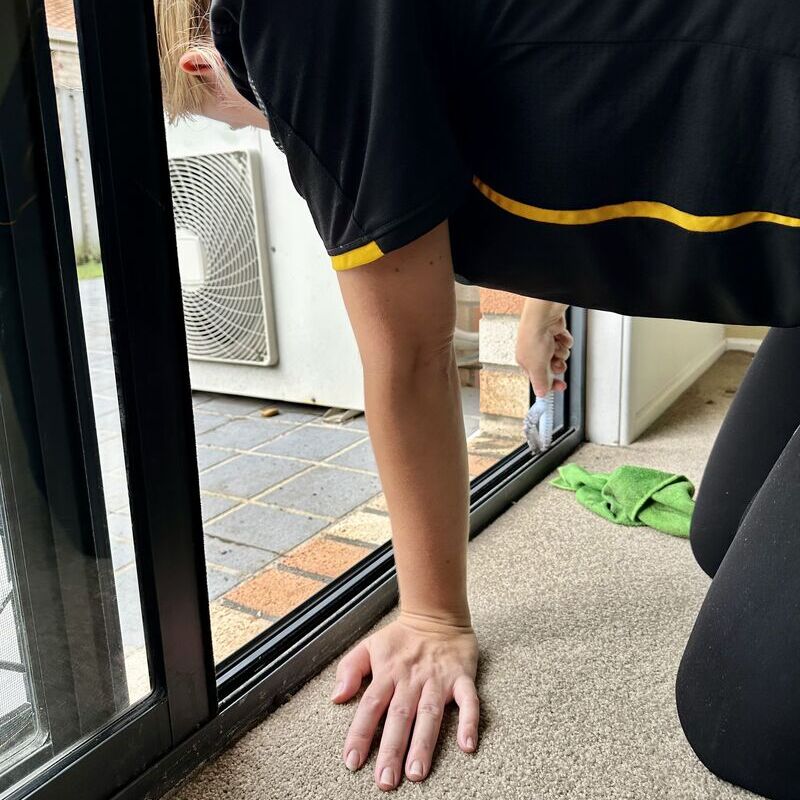There’s nothing more annoying than a sliding door that screeches, drags, or gets stuck halfway.
But when it moves effortlessly and quietly? It’s just so satisfying.
If you want that smooth glide every time, keeping the door tracks spotless is a must.
Luckily, it’s easy to clean door tracks. A quick vacuum and wipe-down with warm, soapy water are usually all it takes!
Say goodbye to noise and jams — here’s a detailed guide on how to clean sliding door tracks.
How Often to Clean | Before Cleaning | Materials You Need | Cleaning Steps | Removing Rust
Why Sliding Door Tracks Need Regular Cleaning
Sliding door tracks might seem like a small detail. However, keeping them clean makes a big difference in how your space looks and feels.
Clean tracks can also help you avoid safety hazards or damage to the door frame and rollers.
Aside from that, they help seal a room properly, keeping out dust, pollen, and even insects.
If you’re moving out of a rental, don’t overlook the tracks! Landlords often check them during the final inspection.
For your peace of mind, consider hiring a professional bond cleaner.
They’ll take care of every corner that’s often overlooked (including door tracks!) to make sure you get your full deposit back.
How Often to Clean Sliding Door Tracks
To keep your sliding door in great shape, here’s how often you should clean the tracks:
- As needed: Pick up large debris and spot clean stains
- Every 1–2 weeks: Vacuum out all loose dirt and dust
- Monthly: Give the track a good wipe-down
- Yearly: Remove the door and do a deep clean
Before Cleaning Your Sliding Door Track
Before getting started, take a look at the sliding door track and check how much cleaning is needed.
If it’s packed with grime, you might need to remove the door to give the track a thorough clean.
Some sliding doors can simply be lifted and tilted out of the track. But if you’re unsure, check the manual or contact a handyman for help.
Most door tracks are made from metals like aluminium, brass, copper, or stainless steel.
Avoid using strong chemicals like ammonia or bleach, as they can permanently discolour metals!
Instead, go for mild cleaners and do a quick spot test first to make sure the product is safe for the surface.
Lastly, do not use abrasive tools like steel wool or rough sponges, which can scratch or dull the finish.
What You Need to Clean Sliding Door Tracks
The best sliding door track cleaner is a mild detergent or dish soap — no need for commercial products!
Here’s a list of everything you need to clean dirty door tracks:
- Vacuum cleaner with a crevice tool
- Mild detergent or dish soap
- Microfibre cloths or rags
- Soft-bristled brush
- White vinegar
- Paper towels
- Butter knife
- Warm water
- Tweezers
Step-by-Step Guide to Cleaning Sliding Door Tracks
Before you start the cleaning process, move nearby objects out of the way so you have plenty of space to work.
Always begin with the top track — use a sturdy step ladder or chair so you can easily reach it. Also, wear safety goggles to protect your eyes from falling dust.
TIP: You can follow these same steps to clean window tracks!
Step 1: Remove loose dirt and debris
Start by removing any large debris — like trapped leaves or insects — from your sliding door track. You can use tweezers if you’re feeling squeamish!
Next, grab a vacuum with a crevice tool. Run it along the track to pick up any visible dirt and dust.
If you can’t reach into tight spaces, get an empty toilet paper roll.
Pinch one end to create a narrow tip, and fit the other end over the vacuum hose attachment.
Secure it with a rubber band or hold it in place as you vacuum. This should help you get into hard-to-reach grooves on the door track.
Step 2: Give the door track a good scrub
After clearing all the debris from the door track, it’s time to give it a good scrub!
In a spray bottle, mix warm water and a bit of dish soap. Spritz the cleaning solution onto your sliding door track.
Wait about 10–15 minutes to allow the soapy water to loosen any dirt buildup.
Then, scrub the door track with an old toothbrush or a grout brush, paying attention to grimy spots.
When you’re done, wipe the door track with a clean, damp cloth to remove any soap residue.
Step 3: Clean tight grooves and corners
The hardest part of cleaning sliding door tracks is getting into tight grooves, which tend to accumulate dirt!
To reach those tiny spaces, take a butter knife or a flat-head screwdriver. Wrap a paper towel around the tip.
Use that to gently scrape along the edges and corners of your door track.
You might need to go over the same areas several times to get everything properly cleaned.
Step 4: Tackle stubborn stains
To remove stubborn stains from your sliding door track, you can use any of the following:
- 3% hydrogen peroxide
- Thick baking soda paste
- Equal parts vinegar and water
Apply the cleaning solution directly onto the affected area, and let it sit for 15–20 minutes to break down the buildup.
Gently scrub the area with an old toothbrush. Wipe away any leftover residue with a cloth dampened with clean water.
Step 5: Let the door track dry thoroughly
After cleaning all stubborn dirt and stains on the door track, wipe everything dry with a paper towel or cloth.
You can also point a fan towards the surface to help it dry faster.
Let the track dry completely before closing the door. This prevents moisture from getting trapped, which can lead to mould or rust.
Step 6: Lubricate the sliding door track
Once the track is clean and dry, you’ll need to lubricate it to keep the door sliding smoothly.
Use a silicone-based lubricant spray. Unlike oil-based types, it creates a dry, slick coating that won’t attract dust or grime.
To apply, follow the instructions on the label.
Then, move the door back and forth a few times to spread the silicone lubricant evenly along the track.
Finally, wipe away any excess product with a clean cloth.
How to Remove Rust from Sliding Door Tracks
For light rust stains on the door track, apply a baking soda paste onto the area.
Wait 15 minutes, gently scrub with an old toothbrush, then wipe off any residue.
If that doesn’t work, dip a cloth into undiluted white vinegar, and use that to rub off the rust stain.
Another option is a commercial rust remover. Follow the product instructions carefully to avoid any damage to your sliding door track.
Remove any residue from the cleaning solution with a damp cloth, and wipe the area dry.
FAQs About Cleaning Door Tracks
Got more questions about cleaning dirty door tracks? Check out these tips to keep your sliding door in top shape!
What is the best way to clean sliding door tracks?
The best way to clean sliding door tracks is with mild detergent or dish soap!
If you’re dealing with stubborn grime like caked-up dust and dirt, use a 1:1 mix of vinegar and water.
For rust stains, you can use a baking soda paste or a commercial rust remover.
Should you use WD-40 on sliding glass door tracks?
WD-40 is not ideal for lubricating sliding door tracks.
Like other oil-based lubricants, WD-40 tends to attract dust and debris, leading to more buildup over time.
For lubrication, a silicone-based product is the better choice, as it doesn’t hold on to dirt.
However, you can use WD-40 for cleaning! It contains solvents that can cut through stubborn grime and is safe to use on most metals.
When you’re done, rinse off all WD-40 residue with a damp cloth and soapy water. Follow with a cloth dipped in plain water, then dry the area.
How do I make my sliding door slide easier?
To keep sliding doors running smoothly, regular maintenance is key.
Debris buildup often causes sliding doors to jam, so make it a habit to vacuum and wipe down the track every 1–2 weeks.
After cleaning, apply a silicone-based lubricant onto the track to help the door glide with ease.
If nothing seems to work, check the door rollers and track for wear or damage.
You may need new door parts to replace worn-out components that can’t be repaired.
Don’t hesitate to call a professional if needed!

